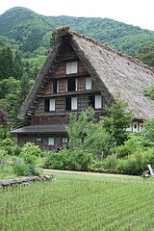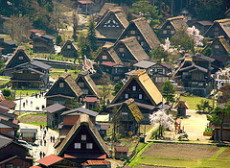World Heritage in Japan 6
Historic Villages of Shirakawago and Gokayama
Historic villages of Shirakawago and Gokayama (Culture, registered in 1995)
A-frame houses were built from mid Edo era to early Showa era in Shirakawa
Village and Gokayama Region. The oldest houses were built 300 years ago.
But many houses have disappeared, some settlements went under water by
the construction of the dam from 1940's, and some settlements have lost
by the fire. The number of A-frame houses were 300 in 1924, but decreased
to 190 in 1961.
Preserve movement has begun after 1965 by the inhabitants of Ogimachi.
It was designated as National important cultural properties in 1976 and
registered as world heritage in 1995. In 1997, foundation for preserving
A-frame houses in Shirakawa-go was established and is doing activities
to preserve the landscape.
A-frame houses became well-known after famous German architect Bruno Taut (1889-1938) introduced them in his book 'Rediscoverly of beauty in Japan'. He lauded 'A-frame house is reasonable and logical from the view of architectonics' and also 'This landscape is not Japanese style. At least I have never seen it before. It seems to be rather Swiss or Swiss illusion'. By this appreciation, it has attracted world's attention.

'A-frame construction' is made by combining two side of the roofs in steep
mountain shape on the beams. The roof is gabled and the surface is thatched.
The weight of the roof is decentralized by the support called 'matakubi'.
You can see this kind of construction in other region, but the characteristics
of the house in Shirakawa is 'Gabled A-fram Construction', the shape looks
as if you open the book face down. This form is to avoid the heavy snow
piles up on the roof. The houses were built facing north-south to minimize
the wind resistance as well as adjusting the amount of sunlight to make
cool in summer and warm in winter.
The difference of A-frame house from normal house is to utilize the attic
as work place. From late Edo era to early Showa era, sericulture was the
key industry in Shirakawa Village. So, they grew silkworms in the attic
dividing the space to 2-4.
The other characteristic is the shape of the roof. Generally the thatched
folk residence has hipped or half-hipped roof, but the residence in Shirakawa
has thatched gabled roof. It related to the sericulture. By bringing the
wind and sunlight, it offers the suitable environment to cultivate silkworm.
The beauty of A-frame comes from the life function.
Now, the number of A-frame house is;
114 in Shirakawa-go (population is about 600)
23 in Gokayamaadays.
(Reference: website of Shirakawa Village Office)
How to access from Tokyo (example)
Tokyo Station-(Shinkansen)-Nagoya Station-(JR)-Takayama Station
-(bus)-Shirakawa-go
*There is a bus between Shirakawa-go and Gokayama but very few and reservation is required.
Total time: About 5 hours

|
|

A-frame houses in Shirakawago
 Top page Top page
 General information of Japan General information of Japan
 World heritage in Japan World heritage in Japan
-Horyuji Temple
-Himeji Castle
-Yaku Island
-Shirakami Mountain Range
-Ancient Kyoto
-Shirakawa-go and Gokayama
-Hiroshima Peace Memorial
-Itsukushima Shrine
-Ancient Nara
-Shrines and Temples in Nikko
-Kingdom of Ryukyu
-Kii Mountain Range
-Shiretoko
-Iwami Silver Mine
-Ogasawara Islands
-Hiraizumi
-Mount Fuji
-Tomioka
-Site of Industrial Revolution
-Architectural Work of Le Corbusier
-Okinoshima & Munakata
 Accommodation in Japan Accommodation in Japan
 Japanese food Japanese food
 Japanese culture (National Treasures) Japanese culture (National Treasures)
 Japanese culture 2 (Culture in everyday life) Japanese culture 2 (Culture in everyday life)
 Japanese sports Japanese sports
 Japanese religion Japanese religion
 Souvenir of Japan Souvenir of Japan
 continually updated ! continually updated !
 Travel Diary in Tokyo Travel Diary in Tokyo
 My profile My profile
 Link Link
 English Guiding Service English Guiding Service
 info@ltij.net
info@ltij.net
|


